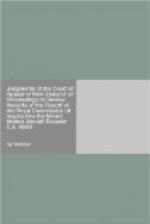Instructions of the Chief Executive
In paragraph 41 and following paragraphs there is reference to “what happened at the airline headquarters at Auckland when the occurrence of the disaster became first suspected and then known”. It is explained that the navigation section became aware of the fact that when the McMurdo waypoint co-ordinates were corrected in November 1979 the movement was not one of 2.1 miles within the vicinity of Williams Field but a distance of 27 miles from longitude 164 deg. 48’ E; and that “by 30 November the occurrence of this mistake over the co-ordinates was known not only to the Flight Operations Division but also to the management of the airline. In particular it had been reported to the Chief Executive of Air New Zealand, Mr. M.R. Davis”. At that point there follows the serious allegation in paragraph 45 already cited—
“The reaction
of the chief executive was immediate. He determined
that no word of this
incredible blunder was to become publicly
known.”
On the face of it the unqualified idea expressed in that sentence is that Mr. Davis had decided to suppress from everybody outside the airline all information about the changed flight track. But if that meaning were intended it has been greatly modified in paragraph 48. There it is said—
“It was inevitable that these facts would become known. Perhaps the chief executive had only decided to prevent adverse publicity in the meantime, knowing that the mistake over the co-ordinates must in the end be discovered.”
Of course if the decision were merely “to prevent adverse publicity in the meantime” then such an attitude could not in any way be consistent with an attempt “orchestrated” by Mr. Davis to hid from official scrutiny what finally was held by the Commissioner in paragraph 393 to be “the single dominant and effective cause of the disaster”. Despite that, paragraph 48 goes on to say this:
“This silence over the changing of the co-ordinates and the failure to tell the air crew was a strategy which succeeded to a very considerable degree. The chief inspector discovered these facts after he had returned from Antarctica on or about 11 December 1979. In his report, which was published in June 1980, the chief inspector referred to what he termed the ‘error’ in the McMurdo destination point, and the fact that it had been corrected a matter of hours before the flight left Auckland.”
It is difficult to understand why the Commissioner considered “this silence over the changing of the co-ordinates and the failure to tell the air crew” had been “a strategy which succeeded to a very considerable degree”. The information had been given to the chief inspector immediately on his return from Antarctica. That much is acknowledged in the two sentences that follow. It becomes apparent, however, that this was criticized not because the information




